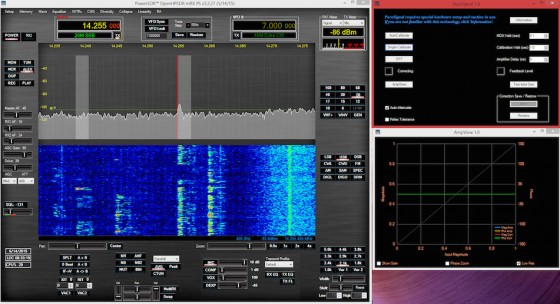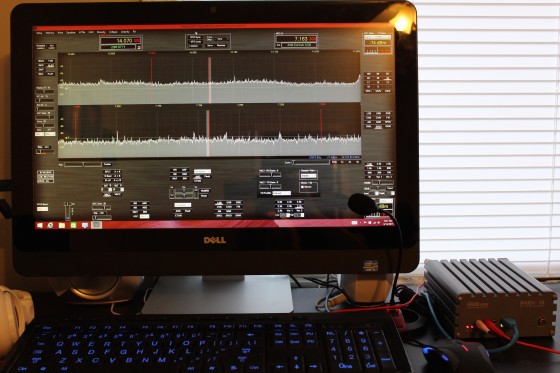
Pure Signal
This can be a pretty deep topic, but basically at the end of the day it is a way to get a very clean output signal from the Anan 10E transmitter. A very crude explanation of this is that PowerSDR_mRX can sample the output of the transmitted signal using the second receiver in realtime. An algorithm is then used to analyze the signal components to remove unwanted IMD (Intermodulation Distortion) components from the transmitted signal. Adaptive pre-distortion modifies the audio modulation signal so that the net result is a flat linear response. Therefore producing a cleaner output signal. This is especially useful when using a linear amplifier along with the Anan 10E. This something you probably won’t find on legacy transceivers for awhile yet. To find out more about PureSignal checkout KC9XG’s Yahoo page.
The Transmitter
As mentioned above, the transmitter in the Anan 10E is rated at 15-20W out on HF and 8-10W on 6M. Which is pretty decent for a high end SDR HF transceiver for under $1000. At this price range you more likely to find an output of around 5W from other SDR transceivers. Anan 10E has more than enough output power for digital use and CW. If you are a SSB operator, coupled with a good antenna the Anan 10E also does a nice job. One of the first things you will want to do is setup your microphone for the most efficient use of output power and audio quality. PowerSDR_mRX has an internal 10 band equalizer to help tweak your output audio quality as well as the receive audio quality. There are several generic how to articles and videos floating around to help you do this. This video by GC7NF is fairly detailed for a Flex 5000 and PowerSDR, but the basic principals will also apply to the Anan and PowerSDR_mRX as well.
Third Party Software / Hardware Support

If you want to use the Anan 10E with other SDR software for receiving such as HDSDR or Studio 1, you can download Extio for HPSDR. PowerSDR_mRX can be interfaced with various digital modes through it’s two internal VAC connections. A great free alternative to the original VAC software is VB-Audio. It is super simple to set up and use compared to the original VAC program. The VB-Audio software is basically free with one VAC cable, but two additional VAC cables can be added with a donation of your choosing to the author. You will also need to get a copy of a Virtual Serial Port program if you want to have the 3rd party software control PowerSDR_mRX or vice versa. This is useful for logging and such as well as having the 3rd party software controlling transmit for digital modes. The Virtual Serial Ports can also be using for controlling other external hardware. If you are a licensed amateur you can request a free copy of VSP-Manager, that will allow you create as many virtual serial ports as you need. If you are not a licensed amateur you may want to check out VSPE from Eterlogic. VSPE is free for 32bit Windows users, but because of licensing requirement the 64bit version is $24.95. There are other serial port emulators, but VSP-Manager and VSPE are known to work pretty well with the current 3rd party amateur radio applications. PwerSDR_mRx currently offers 5 CAT connections. Four of these can be used to control 3rd party software apps and one for PTT control. Also PowerSDR_RX’s collapsable display makes it more “screen real-estate friendly” when using 3rd party apps since you just display the basic controls and spectrum / waterfall display in a smaller area.
Speaking of external hardware. Support for some of the Hercules DJ controllers is built into PowerSDR_mRX. The controllers are setup through the Midi tab in the PowerSDR_mRX setup section. The DJ controllers jog wheels, sliders, and buttons can be mapped to control the various features of PowerSD_mRX to your liking. This actually winds up being a very nice feature because you now have to big VFO jog wheels for tuning the dual VFOs, plus sliders for volume controls and buttons for triggering transmit and such. This setup provides a nice tactile interface to PowerSDR-mRX and is well worth the money to implement. However there is a fly in the ointment that needs to be addressed. The Midi code is now pretty dated, all but one of the Hercules controllers originally supported by the Midi code is still being sold. This code needs to be updated to support newer devices or provide a “learning capability” to allow interfacing to any external midi device. It would also nice if two way Midi control would be implemented. This would allow PowerSDR_mRX to toggle the various led lights on the controller so you could see your software settings at a glance. Until then, PowerSDR_mRX is supposed to support the following Hercules DJ controllers:
Hercules DJ Console MP3e2 (not sold anymore)
Hercules DJ Console MK2 (not sold anymore)
However the Hercules DJ Control MP3 LE shown below can still be purchased new on Amazon.


Reduction of ADC # of bits by 2 reduces dynamic range by 1S unit ( -6dB)!
I wonder how one copes with this with respect to settings of gain distribution according to K3NA excellent recommendations ( google)!
Pierre,
F3WT
The 14-bit LTC2208 has a noise floor of -77.1 dBFS versus -78 for the 16-bit part. The SFDER is 98 dB versus 100 dB. I think the difference in *effective* number of bits is less than 1. The Perseus uses the 14-bit part and its performance is extremely close to that of designs using the 16-bit part.
Now, has anyone actually *measured* the performance difference in receive between the ANAN-10 and the ANAN-10E? Apart from advertising claims and some hand waving, I have seen no actual measured data published.
Thanks!
73,
Lyle KK7P
the calculation is not correct: 2 bits less cause a nominal degration of DR of 2 x 6.02dB = 12.04 dB! But we have to consider the ENOB ( effective number of bits)defined for each ADC and there difference is not so significant. We measured approx. 4 dB reduction
I have both the 10E and the 100D. Since I am a low band operator (160m primarily) the 100D is AWESOME!. With narrow filters and the NB2 noise reduction I can even use my transmit antenna and copy very weak signals. I have used both the 10E and 100D on an A/B comparison and the difference is barely noticeable. There is a new model about to be released and if the software can keep up with the new hardware the Flex users will soon be Apache Labs followers.